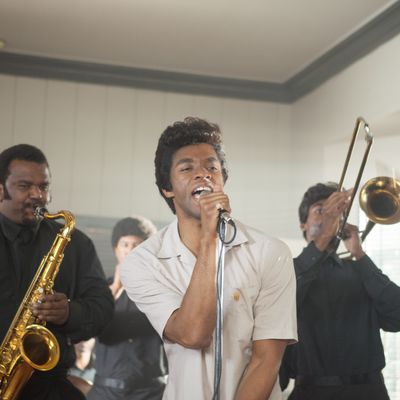
I’m no James Brown expert, so I can’t speak much to the accuracy of Get on Up. But it seems pretty clear that accuracy isn’t its bag. Unspooling as a decidedly non-linear, almost stream-of-consciousness journey through Brown’s life and career, Tate Taylor’s film cares less about narrative clarity and more about portraying a life lived between the extremes of sin and grace, between the abject and the sublime. It’s lively, stylized, and genuinely surprising.
The story plays out in flashback from a 1988 incident that landed Brown (Chadwick Boseman), then some years removed from the height of his fame, in jail. Arriving at one of his offices in a third-rate strip mall in Augusta, Georgia, the strung-out singer bursts into an insurance seminar next door wielding a shotgun, demanding to know who used his adjoining bathroom: “Which one of you gentle folk hung a No. 2 in my commode?” he yells. When one terrified woman fesses up, Brown quiets down and becomes almost avuncular, telling her that she’s just like him: “You did right by yourself. There ain’t no other way to live.” Goofy way to start a prestige biopic, no doubt, but smart, too: By kicking things off on such a weirdly pathetic note, the film partly inoculates itself against any charges it might whitewash Brown’s complicated life.
We then hop briefly to Brown’s visit to Vietnam at the height of the war, as the plane carrying him and his bandmates comes under attack. “They tried to kill James Brown today!” he yells in disbelief. “Who wants to go down in history as the one that killed the funk?” This is Brown at the height of his fame, and his bizarre grandiosity is now a pop icon’s swagger — he’s part of a canvas that’s just big enough to contain him. And then, just as suddenly, we’re in 1930s Georgia, where young James lives in a dirt-poor shack in the woods. He watches his father beat his mother, but he also sees how she continues to be drawn to this brute of a man — a sly hint that Brown got the wrong idea about men and women at a fairly young age.
This time-skipping, card-shuffling structure isn’t as random as it looks. Taylor and screenwriters Jez and John-Henry Butterworth constantly juxtapose moments of triumph or inspiration with scenes of baseness or horror. We see young James wander into a church where he watches a man, all decked out in white, dancing and singing up a storm, a vision of things to come; then we see him stealing a suit from a car and landing in jail for the first time. We see young James beaten by his father; then we cut immediately to an older James singing “I Feel Good” to a select studio audience of smiling lily-white kids. (“It’s a honkey hoedown!” he remarks.)
Sometimes, all that grace and horror come within the same scene: In one of the film’s more surreal (though probably not inaccurate) setpieces, young James participates in a “charity extravaganza” put on by some rich white southerners, during which black boys are stripped to their bare chests, painted with a number, blindfolded, and made to fight each other with one hand. James is hit and falls, and then spies a black jazz band playing in the corner — almost as if they’re playing just for him. The music transforms him, revitalizes him, sets him free.
Such an approach demands a lot of Boseman and the rest of the fine cast (particularly Nelsan Ellis, as Brown’s longtime collaborator Bobby Byrd). There’s no clean path through the movie on which the actors can hang traditional emotional trajectories. So the performances are broad and mannered as opposed to realistic; the actors are forced to wear the emotions of the moment on their sleeves. Because the film doesn’t draw lines; it draws contrasts.
Get on Up may skimp on the life details and the subtlety, but it thankfully doesn’t skimp on the music. Taylor stages Brown’s concerts with verve, capturing the rhythmic ferocity of the backup dancers, the charge of the crowd, the collective sense that, during a James Brown performance, anything could happen. Boseman has the dance moves down, even if he doesn’t quite have the real-life Brown’s loose-limbed, frenetic stage presence; he doesn’t quite seem like a man possessed. One could say that the movie works on that same level. It’s an admirable, energetic attempt to come to terms with the wild contrasts of James Brown’s life, even if the man himself remains elusive. Don’t be surprised if you come out of Get on Up with more questions than you did going in.


